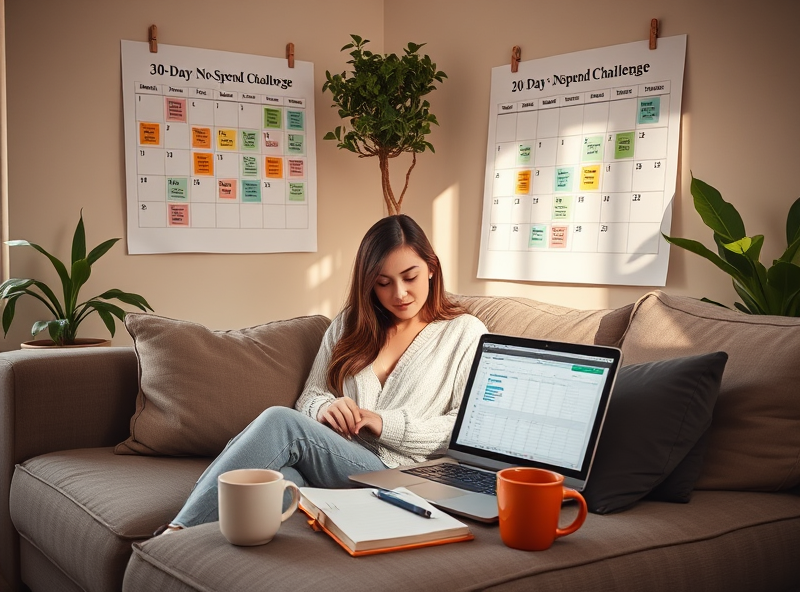
No-Spend Challenge: How to Save More Money in Just 30 Days Without Feeling Deprived

Saving money doesn’t have to feel like a punishment. In fact, a No-Spend Challenge can be a fun and eye-opening way to take control of your finances without feeling deprived. As a financial wellness advocate living in the U.S., I’ve seen firsthand how a 30-day no-spend challenge can reset spending habits, increase savings, and even boost mental clarity. Let’s explore how you can start your own challenge, what to expect, and how to make it a success.
What Is a No-Spend Challenge?
A No-Spend Challenge is a self-imposed spending freeze where you commit to not spending money on non-essential items for a set period—typically 30 days. Essentials like rent, utilities, groceries, and medical expenses are still allowed, but discretionary spending (like dining out, shopping, or entertainment) is off-limits.
This challenge is not about deprivation—it’s about mindfulness. It helps you identify spending triggers, evaluate needs versus wants, and develop healthier financial habits.
Why Try a No-Spend Challenge?
According to the U.S. Bureau of Economic Analysis, the personal savings rate in the U.S. has fluctuated significantly over the past decade, often dipping below 5%. A No-Spend Challenge can help reverse this trend by encouraging intentional spending and saving.
Benefits include:
– Increased savings in a short time
– Improved financial awareness
– Reduced impulse spending
– A clearer understanding of financial priorities
How to Prepare for Your 30-Day No-Spend Challenge
Preparation is key to success. Here’s how to get started:
1. Define Your Rules: Decide what counts as a “no-spend” item. For example, you might allow groceries but not takeout.
2. Set a Goal: Are you saving for an emergency fund, debt repayment, or a vacation? A clear goal keeps you motivated.
3. Inform Your Circle: Let friends and family know about your challenge. This helps avoid social pressure to spend.
4. Plan Ahead: Meal prep, schedule free activities, and avoid shopping triggers.
What to Do Instead of Spending
You don’t have to sit at home bored. There are plenty of free or low-cost alternatives:
– Visit your local library (many offer free events and workshops)
– Explore free community events or parks
– Start a DIY project using materials you already have
– Cook new recipes with pantry staples
– Declutter and sell unused items online
Tracking Your Progress
Use a journal, spreadsheet, or budgeting app like Mint or YNAB (You Need A Budget) to track your spending—or lack thereof. This helps you stay accountable and see how much you’re saving.
Common Challenges and How to Overcome Them
– Temptation to Spend: Unsubscribe from marketing emails and avoid browsing online stores.
– Social Pressure: Suggest free alternatives like potlucks or game nights.
– Boredom: Rediscover hobbies or learn a new skill using free online resources like Coursera or YouTube.
What Happens After the 30 Days?
After the challenge, review your progress:
– How much did you save?
– What did you learn about your spending habits?
– What habits do you want to keep?
Many people find they naturally continue to spend less even after the challenge ends. Consider doing the challenge quarterly or seasonally to keep your finances in check.
Final Thoughts
A No-Spend Challenge is more than just a money-saving exercise—it’s a mindset shift. It teaches you to be intentional with your money and appreciate what you already have. With a little planning and creativity, you can complete the challenge without feeling deprived—and come out financially stronger.
Disclaimer
This blog post is for informational purposes only and does not constitute financial advice. Please consult with a certified financial advisor or professional before making any major financial decisions. The author is not responsible for any financial outcomes resulting from the implementation of ideas discussed in this article.
Sources
– U.S. Bureau of Economic Analysis. “Personal Saving Rate.” https://www.bea.gov/data/income-saving/personal-saving-rate








답글 남기기